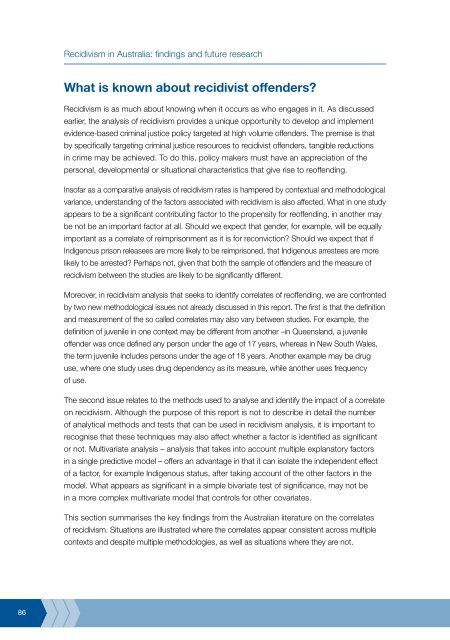Recidivism in Australia : findings and future research - Australian ...
Recidivism in Australia : findings and future research - Australian ...
Recidivism in Australia : findings and future research - Australian ...
Create successful ePaper yourself
Turn your PDF publications into a flip-book with our unique Google optimized e-Paper software.
86<br />
<strong>Recidivism</strong> <strong>in</strong> <strong>Australia</strong>: f<strong>in</strong>d<strong>in</strong>gs <strong>and</strong> <strong>future</strong> <strong>research</strong><br />
What is known about recidivist offenders?<br />
<strong>Recidivism</strong> is as much about know<strong>in</strong>g when it occurs as who engages <strong>in</strong> it. As discussed<br />
earlier, the analysis of recidivism provides a unique opportunity to develop <strong>and</strong> implement<br />
evidence-based crim<strong>in</strong>al justice policy targeted at high volume offenders. The premise is that<br />
by specifically target<strong>in</strong>g crim<strong>in</strong>al justice resources to recidivist offenders, tangible reductions<br />
<strong>in</strong> crime may be achieved. To do this, policy makers must have an appreciation of the<br />
personal, developmental or situational characteristics that give rise to reoffend<strong>in</strong>g.<br />
Insofar as a comparative analysis of recidivism rates is hampered by contextual <strong>and</strong> methodological<br />
variance, underst<strong>and</strong><strong>in</strong>g of the factors associated with recidivism is also affected. What <strong>in</strong> one study<br />
appears to be a significant contribut<strong>in</strong>g factor to the propensity for reoffend<strong>in</strong>g, <strong>in</strong> another may<br />
be not be an important factor at all. Should we expect that gender, for example, will be equally<br />
important as a correlate of reimprisonment as it is for reconviction? Should we expect that if<br />
Indigenous prison releasees are more likely to be reimprisoned, that Indigenous arrestees are more<br />
likely to be arrested? Perhaps not, given that both the sample of offenders <strong>and</strong> the measure of<br />
recidivism between the studies are likely to be significantly different.<br />
Moreover, <strong>in</strong> recidivism analysis that seeks to identify correlates of reoffend<strong>in</strong>g, we are confronted<br />
by two new methodological issues not already discussed <strong>in</strong> this report. The first is that the def<strong>in</strong>ition<br />
<strong>and</strong> measurement of the so called correlates may also vary between studies. For example, the<br />
def<strong>in</strong>ition of juvenile <strong>in</strong> one context may be different from another –<strong>in</strong> Queensl<strong>and</strong>, a juvenile<br />
offender was once def<strong>in</strong>ed any person under the age of 17 years, whereas <strong>in</strong> New South Wales,<br />
the term juvenile <strong>in</strong>cludes persons under the age of 18 years. Another example may be drug<br />
use, where one study uses drug dependency as its measure, while another uses frequency<br />
of use.<br />
The second issue relates to the methods used to analyse <strong>and</strong> identify the impact of a correlate<br />
on recidivism. Although the purpose of this report is not to describe <strong>in</strong> detail the number<br />
of analytical methods <strong>and</strong> tests that can be used <strong>in</strong> recidivism analysis, it is important to<br />
recognise that these techniques may also affect whether a factor is identified as significant<br />
or not. Multivariate analysis – analysis that takes <strong>in</strong>to account multiple explanatory factors<br />
<strong>in</strong> a s<strong>in</strong>gle predictive model – offers an advantage <strong>in</strong> that it can isolate the <strong>in</strong>dependent effect<br />
of a factor, for example Indigenous status, after tak<strong>in</strong>g account of the other factors <strong>in</strong> the<br />
model. What appears as significant <strong>in</strong> a simple bivariate test of significance, may not be<br />
<strong>in</strong> a more complex multivariate model that controls for other covariates.<br />
This section summarises the key f<strong>in</strong>d<strong>in</strong>gs from the <strong>Australia</strong>n literature on the correlates<br />
of recidivism. Situations are illustrated where the correlates appear consistent across multiple<br />
contexts <strong>and</strong> despite multiple methodologies, as well as situations where they are not.















